| PRESS RELEASE |
| For immediate release: March 4, 2019 |
| High Energy Accelerator Research Organization (KEK) Japan Proton Accelerator Research Complex (J-PARC) Center |
| |
| KOTO Experiment at J-PARC Hadron Experimental Facility Broke World's Best Sensitivity on Rare Neutral Kaon Decay by an Order of Magnitude - first step forward elucidation of "matter-antimatter asymmetry" - |
| |
 【 Notable Points 】 【 Notable Points 】  ✣ In the J-PARC experiment, the collaboration achieved the improvement by an order of magnitude in the sensitivity to search for the rare neutral-kaon decay. ✣ The collaboration has begun to elucidate the matter-antimatter asymmetry (CP symmetry breaking) in the universe through kaon decays.
|
| |
 【 Synopsis 】 【 Synopsis 】 
|
| |
An international collaboration reported the first major results from the experiment KOTO, which is being conducted at the Hadron Experimental Facility of Japan Proton Accelerator Research Complex (J-PARC). The KOTO collaboration set the upper limit of once in three hundred million on the rate of the neutral K-meson (kaon) decay into a neutral pi meson and a pair of neutrinos from the analysis of the data set collected in 2015, and improved the world's best sensitivity by an order of magnitude. The collaboration has begun to elucidate the matter-antimatter asymmetry (CP symmetry breaking) in the universe through kaon decays. As the prospects for future, further improvements on the sensitivity with data collected since 2016 are anticipated. The collaboration upgraded the KOTO detector in the autumn of 2018, and started to take the new data with it in February 2019.
|
The results have been published in the 18-January-2019 issue of the journal PHYSICAL REVIEW LETTERS.
|
| |
 【 Background of this research】 【 Background of this research】 
|
| |
The matter-antimatter asymmetry (CP symmetry breaking) in the universe is a big mystery in modern physics. This phenomenon was discovered in 1964 in measuring K-meson (kaon)#1 decays#2; United States physicists J.Cronin and V.Fitch, who performed the experiment, received the Nobel Prize in Physics in 1980. At KEK, the Belle experiment of the KEK B Factory measured the CP symmetry breaking in B-meson decays and verified the theory proposed by M.Kobayashi and T.Maskawa, who received the Nobel Prize in Physics in 2008. The Kobayashi-Maskawa theory explained the properties of B-mesons well, and is embedded in the standard model (SM) of particle physics. However, the asymmetries measured so far by experiments are insufficient to account for the reason why the antimatter has disappeared in the current universe. In addition to the Kobayashi-Maskawa theory, there should be new physics beyond the SM and the new matter-antimatter asymmetry due to it. The Belle II experiment of the Super KEK B Factory, the T2K long-baseline neutrino oscillation experiment of J-PARC, and many research projects in the world are underway for the purpose to pursue the mystery of matter-antimatter asymmetry.
|
The decay of neutral kaon KL, where L of KL means the long-lived one of neutral kaons#3, into a neutral pi meson (pion) π0 , a neutrino ν and an antineutrino, in enormous number of kaons, is searched for to elucidate the matter-antimatter asymmetry through kaon decays. This decay, Kʟ → π0νῡ, occurs once in thirty billion decays in the prediction of the SM. New sources of matter-antimatter asymmetry due to new physics may be revealed most clearly in the Kʟ → π0νῡ decay, particularly in the cases where the decay occurs in several times or several-score times higher rates than the predicted one.
|
Thus, efforts have been underway for many years to improve the sensitivity to search for the Kʟ → π0νῡ decay. The world's best limit so far, once in forty million, was obtained by the E391a experiment performed in the 2000s for six months at the KEK 12GeV proton synchrotron. To improve the sensitivity further and aim for observation of the rare decay, a new KOTO experiment by using the high-intensity proton beam of the Japan Proton Accelerator Research Complex (J-PARC), located at Tokai-mura in Ibaraki Prefecture, Japan, is being conducted.
|
 【 Description of the research and results 】 【 Description of the research and results 】 
|
| |
At the Hadron Experimental Facility of J-PARC, an international collaboration (Spokesperson: Prof. Taku Yamanaka, Department of Physics, Osaka University, Co-spokesperson: Prof. Yau W. Wah, Enrico Fermi Institute, University of Chicago) is conducting the search for the rare neutral-kaon decay Kʟ → π0νῡ. The name of the experiment KOTO is short for "K0 at Tokai"; 69 collaborators are from Osaka University, KEK, J-PARC Center, Kyoto University, Yamagata University, National Defense Academy, Saga University and Okayama University of Japan, University of Chicago, University of Michigan and Arizona State University of the United States, National Taiwan University of Taiwan, Korea University, Chonbuk National University and Jeju National University of Korea and JINR of Russia (Figure 1). The experiment is supported by Ministry of Education, Culture, Sports, Science, and Technology (MEXT) of Japan; the Japan Society for the Promotion of Science (JSPS); the U.S. Department of Energy, Office of Science, Office of High Energy Physics; the Ministry of Education and the National Science Council/Ministry of Science and Technology in Taiwan; and the National Research Foundation of Korea. No other Kʟ → π0νῡ experiment is present as of 2019.
|
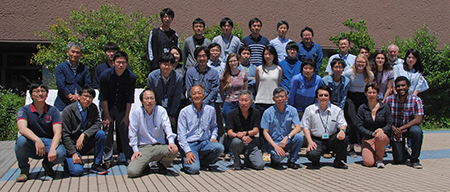 * Click here to enlarge. * Click here to enlarge. |
| Figure 1 : Group photo of the KOTO collaborators taken in June 2018 at Tokai. |
In the Hadron Experimental Facility, a proton beam with the kinetic energy of 30 GeV, extracted from the Main Ring accelerator to the experimental hall, strikes a gold target and produces secondary particles for particle and nuclear physics experiments. For the KOTO experiment, neutral kaons produced in the target are transported via the 20-meter-long neutral beam line to the experimental area in the south floor of the hall. Detector components are located inside the cylindrical vacuum vessel with the diameter of 4 meters and the length of 6 meters, and catch the particles from neutral kaon decays in vacuum (Figures 2 and 3). Neutrinos in the Kʟ → π 0νῡ decay are undetected; two gamma-rays from a neutral pion that decays immediately are precisely measured with the electromagnetic calorimeter #4 located downstream. If there were other detectable particles in a kaon decay the event should not be Kʟ → π 0νῡ for hermetic detection of extra particles to reject such background events, gamma-ray and charged-particle veto counters covers the kaon decay volume
|
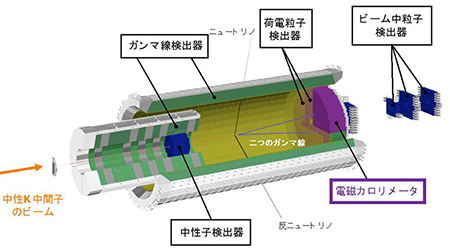 * Click here to enlarge. * Click here to enlarge. |
| Figure 2 : Schematic view of the detector system of the KOTO experiment. The neutral kaon beam enters from the left. The electromagnetic calorimeter in purple measures two gamma-rays from a neutral pion. |
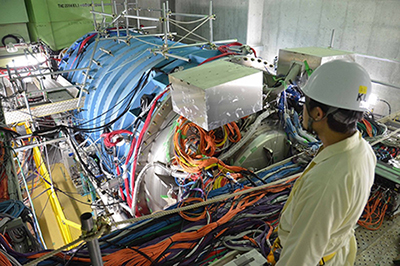 * Click here to enlarge. * Click here to enlarge. |
| Figure 3 : Photo of the detector system of the KOTO experiment in the Hadron Experimental Facility of J-PARC. The tank painted in blue is the vacuum vessel. |
The KOTO collaboration constructed the beam line in 2009 and the electromagnetic calorimeter in 2010. After the East Japan Earthquake the collaboration finished the detector construction in 2012 and collected the first data for a few days in 2013. From April 2015, when the Hadron Experimental Facility resumed the user operation, KOTO started the genuine data taking.
|
It is very difficult to discriminate and identify the Kʟ → π0νῡ signal from the background events due to primary kaon decays: Kʟ → π0π0π0, Kʟ → π0π0, Kʟ → π0π+π-, etc. and due to neutrons contained in the neutral beam. Several detector components have been upgraded even after the detector construction was finished. A long and thoughtful data analysis has to be made.
|
The first major results reported this time is from the analysis of the data set collected for 68 days in total during the user operation of the Hadron Experimental Facility in 2015 from April to June and from October to December. The rate of the Kʟ → π0νῡ decay is less than once in three hundred million, which is so far the most stringent upper limit on the decay (Figure 4) .
|
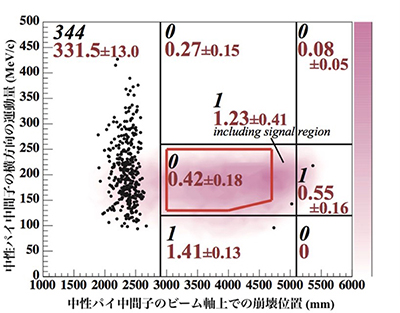 * Click here to enlarge. * Click here to enlarge. |
| Figure 4 : Final plot representing the results of the KOTO experiment from the analysis of the 2015 data set. The decay vertex position (Zvtx) and the transverse momentum (Pt) of the neutral pion in the horizontal and vertical axes, respectively, were calculated assuming that the vertex was on the beam axis. The black italic (red regular) numbers indicate the numbers of observed (expected background) events for the regions inside the lines. No Kʟ → π0νῡ candidate events were observed in the signal region surrounded by red lines. |
| |
 【Significance of the results and future prospects】 【Significance of the results and future prospects】 
|
| |
The new results from the KOTO experiment improved the world's best sensitivity to search for the Kʟ → π0νῡ decay by an order of magnitude. The KOTO collaboration has begun to elucidate the matter-antimatter asymmetry in the universe through kaon decays. The collaboration upgraded the gamma-ray detectors in 2016 and collected data from 2016 to 2018, which corresponds to 1.4 times larger than the data in 2015. The analysis is currently undertaken intensively, and further improvements on the sensitivity are anticipated. In the autumn of 2018 the collaboration upgraded the electromagnetic calorimeter to significantly suppress the background events due to neutrons. A data taking with the new detector system started in February 2019. By improving the sensitivity and approaching to the predicted rate in the SM, the experiment makes strides toward exploring new physics beyond the SM and the new matter-antimatter asymmetry due to it.
|
| |
 【 Publication 】 【 Publication 】 
|
J.K.Ahn et al.(KOTO Collaboration), "Search for Kʟ → π0νῡ and Kʟ → π0X0 Decays at the J-PARC KOTO Experiment," Physical Review Letters 122, 021802 - Published 15 January 2019
|
 【 Contacts 】 【 Contacts 】 
|
<< on physics contents >> Osaka University Department of Physics, Professor / KOTO Spokesperson Taku YAMANAKA E-mail:taku[at]champ.hep.sci.osaka-u.ac.jp
|
University of Chicago Enrico Fermi Institute, Professor / KOTO Co-spokesperson Yau W. Wah E-mail:ywah[at]uchicago.edu
|
High Energy Accelerator Research Organization (KEK) Institute of Particle and Nuclear Studies, Professor Takeshi KOMATSUBARA E-mail:takeshi.komatsubara[at]kek.jp
|
<< for Media >> High Energy Accelerator Research Organization (KEK) Public Relation Office, Head Hajime HIKINO E-mail:press[at]kek.jp
|
High Energy Accelerator Research Organization (KEK) Institute of Particle and Nuclear Studies, Public Relation Coordinator Hiroko TADA E-mail:takeshi.htada[at]post.kek.jp
|
J-PARC Center Public Relation Section, Leader Minako ABE E-mail:abe.minako[at]jaea.go.jp
|
*Please replace "[at]" with "@" |
 【 Footnotes 】 【 Footnotes 】 
|
#1 K-meson (kaon) A K-meson is any of a group of particles which contains a strange quark (s), which belongs to the second generation of quarks in particle physics. More explicitly speaking, a "charged K-meson (K+) "is the bound state of a strange antiquark and an up quark (u) and a "neutral K-meson (K0) "is the bound state of a strange antiquark and a down quark (d); both the up and down quarks belong to the first generation. There also be the antiparticles of a charged K-meson and a neutral K-meson, K- and K0 , as shown in Figure 5. There are two neutral K-mesons, K0 and K0 , which are a particle and an antiparticle.
|
| |
 * Click here to enlarge. * Click here to enlarge. |
Figure 5 : Four K-mesons (kaons) containing a strange quark. |
| |
#2 decay Heavy particles, produces by high-energy collisions of particles, have a transition to lighter particles over time. This occurs in a very short time, say in one billionth of a second. This phenomenon, due to the interactions of the quarks in the particles, is called "decay" in particle physics. The decay of a particle proceeds via several paths or decay modes. By examining the pattern of decays, quark interactions can be understood.
|
#3 long-lived neutral kaon Two neutral kaons K0 and K0 are a particle and an antiparticle. Their superposition makes them into a long-lived neutral kaon(KL) and a short-lived one(KS). Due to the way of superposition, KL has a property of CP odd. The system of a neutral pion and a pair of neutrinos has a property of CP even. Thus, the Kʟ → π0νῡ decay changes the CP property from odd to even during the transition and breaks the CP symmetry.
|
#4 electromagnetic calorimeter An electromagnetic calorimeter is a particle detector to measure the incident position, timing and energy of gamma-rays. The calorimeter of the KOTO experiment was built by stacking two types of 50-centimeter-long undoped Cesium Iodide (CsI) crystals, with 2.5-centimeter-squared and 5-centimeter-squared in their cross sections, inside the cylinder of 2 meter in the diameter (Figure 6). The CsI crystals had originally been used in a kaon decay experiment named KTeV at the Fermi National Accelerator Laboratory in the United States in 1990s, and were transferred to Japan through the Japan-U.S. Cooperative Research Program in High Energy Physics. The energy of gamma-rays is transformed to light emission of CsI crystals, the emission is converted to electronic signals and their waveform is recorded by custom-made high speed electronic circuits made by University of Chicago and a data acquisition system built by University of Michigan.
|
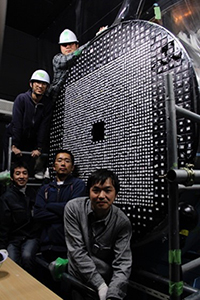 * Click here to enlarge. * Click here to enlarge. |
Figure 6 : Photo of the electromagnetic calorimeter taken in February 2011, when the stacking of the CsI crystals was completed. |
| |
- end of this document - |
|
©2019 J-PARC Center. All rights reserved. |

